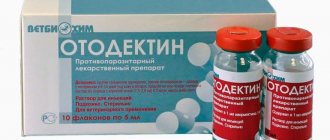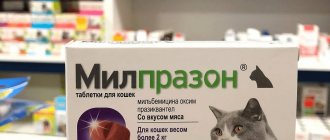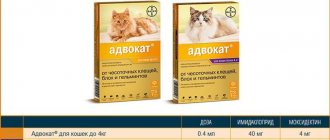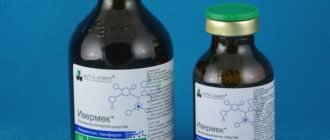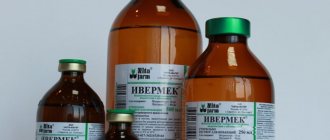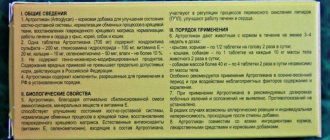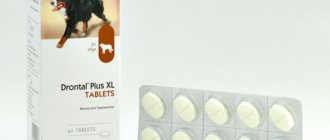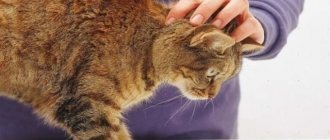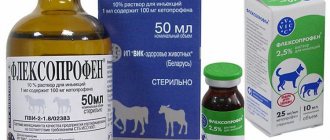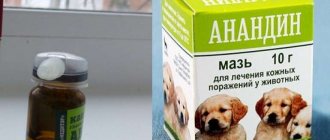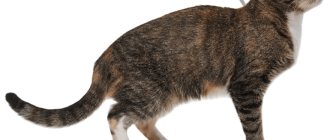COMPOUND
Active substance:
- Feliferon for cats, according to the instructions, 1 ml contains feline interferon with antiviral activity of 400,000 IU as an active ingredient
Excipients:
- dextran-40 50.00 mg
- sodium salt of ethylenediaminetetraacetic acid 0.07 mg
- sodium acetate 1.64 mg
- sodium chloride 5.84 mg
- polysorbate-20 0.10 mg
- glacial acetic acid about 0.0045 ml
- water for injection up to 1 ml
general description
Feliferon is an immunomodulator, which is available in the form of an injection solution. In appearance it is usually transparent and colorless, with occasional slight turbidity. The medicinal solution has no odor. For its packaging, glass bottles with a volume of 3 ml are used, but 2.5 ml of liquid is placed in each container. The drug can only be stored in sealed packaging, so the bottles are sealed with rubber stoppers, which must be rolled up with aluminum caps.
The composition of the drug is based on cat interferon, the antiviral activity of which is 400,000 IU (international units). Interferons are proteins that are produced in the body in response to an attack by viruses. The composition also includes acetic acid, which maintains the acidity level at pH 4.5-5.0, and other auxiliary components:
- sodium acetate;
- polysorbate;
- sodium chloride;
- dextran;
- purified water, etc.
The medicinal properties can be preserved only if certain storage conditions are met. Storage temperature should be between 2 and 8 degrees above zero. One-time freezing is allowed, but at a temperature of at least -25 degrees. For storage, choose a dry place, away from sunlight.
Note! If the bottle is opened, the medicine is suitable for treatment only for 5 days. Then it needs to be disposed of. No special measures need to be taken.
PHARMACOLOGICAL PROPERTIES OF FELIFERON
Pharmacological group: immunomodulators, drugs with antiviral activity. Feliferon for cats has an immunostimulating and antiviral effect.
The mechanism of action consists of:
- increased phagocytic activity of macrophages in cats
- increasing the specific cytotoxicity of lymphocytes
- increasing the resistance of healthy cells of the cat’s body to infection with viruses
- in suppressing the reproduction of RNA and DNA viruses in infected cells
According to the degree of impact on the cat’s body, Feliferon is classified as a low-hazard substance
(grade 4), in recommended doses does not have a skin irritant or resorptive toxic effect.
Contraindications and side effects
And although Feliferon is considered a safe drug for cats, it has contraindications. It can cause more harm than good to an animal’s body in the following cases:
- for autoimmune diseases;
- for allergic pathologies that occur in severe form;
- in case of intolerance to components.
The immunostimulant is generally well tolerated by pets and can be used on cats of all ages, including kittens. When using this medication on kittens or pregnant cats, consult your doctor. Even exceeding the dose usually does not have negative consequences for animals.
If you are intolerant to the substances included in the composition, an allergy may occur, which is manifested by a rash, vomiting, itching or other unpleasant symptoms. In this case, stop using Feliferon. To alleviate the suffering of the animal, it is given an antiallergenic drug and, if necessary, symptomatic treatment is prescribed.
Why use Feliferon to treat cats?
According to the instructions, feliferon is designed for the treatment of viral diseases of cats. Field studies of cats with calicivirus infection have shown a reduction in the severity and duration of clinical signs associated with the virus. The drug has also been used in the adjunctive therapy of cats with infectious peritonitis with uncertain clinical results.
Feliferon for cats has been used experimentally in the treatment of feline viral infections, including leukemia, immunodeficiency and coronavirus infection.
Feline interferon given prophylactically or therapeutically to cats experimentally infected with FIP does not reduce mortality. However, the high-dose protocol resulted in transient suppression of clinical signs and decreased serum antibody titers to FIP with increased survival time (weeks) compared to untreated cats. There are no good studies on the effect of this treatment on spontaneously occurring FIP infection, although one protocol has been described using human interferon alpha 30 IU/day orally for 7 days on alternating weeks for 6–7 weeks.
Feliferon in cats is indicated for the treatment of herpes keratitis.
Trials are currently underway to examine the potential benefits of interferon therapy for feline chronic gingivostomatitis.
Owner reviews
Sonya, owner of a Persian cat:
“Our Basya caught a disease very similar to the human cold. She lay there and did not move, her nose was hot, liquid was constantly flowing from it. The doctor said that the cat had a viral infection and prescribed several medications, including Feliferon. Already on the second day, the cat began to eat on its own, and a day later, it started running around the apartment again.”
Svetlana, owner of a 5-year-old cat:
“While staying at the dacha, the cat became ill. At first we thought it was poisoning because she was vomiting and diarrhea a lot. But she kept getting worse, so she urgently had to go to the city. Later we found out that our pet had feline distemper. In addition to a number of medications, we were prescribed Feliferon, and I believe that it was this that helped our cat recover. She came to life right before our eyes. After the first injection she felt better. A total of 5 injections of 1 ml were given.”
Rinata, owner of 2 cats:
“When my cats started sneezing and coughing, I immediately called a veterinarian to the house. He diagnosed rhinotracheitis. For treatment, he prescribed us Feliferon along with vitamins, antibiotics and other medications. The doctor highly recommended injecting this remedy and explained why. I was pleased with the result. The cats recovered quite quickly, so I can judge the effectiveness of this drug.”
INDICATIONS
Feliferon is prescribed to cats according to the instructions for use for therapeutic and prophylactic purposes for:
- feline herpesvirus (rhinotracheitis)
- panleukopenia
- calicivirus
- anemia and hypovitaminosis
- in the postoperative period
- in the postpartum period
- secondary immunodeficiency
- gastrointestinal
- invasive diseases
- acute respiratory
- poisoning
- other diseases of viral or mixed etiology
Possible side effects
As a rule, with proper use of the drug, no adverse reactions are observed. The only exception is the individual reaction of the animal, which manifests itself in the form of a severe allergic attack. In this case, the cat must immediately be given any antihistamine and seek help from a veterinarian.
If you use Feliferon strictly according to the instructions, following all the doctor’s instructions, then it will only bring benefits to the animal’s body, relieve serious viral infections, and strengthen the immune system.
MODE OF APPLICATION
Feliferon solution for injection is administered intramuscularly to cats. If there is a threat of infection, the drug is prescribed at a dose of 200,000 IU per animal, twice with an interval of 48 hours. For the treatment of cats with viral, bacterial and mixed diseases, Feliferon is administered in a daily dose of 200,000 IU, for 5-7 days in combination with antibiotics, serum and immunoglobulin preparations, in accordance with the instructions for their use.
In severe cases of the disease and mixed infections, it is recommended to increase the average therapeutic dose by 2 times - 400,000 IU.
No overdose symptoms have been identified when using the drug. Avoid missing the next dose of Feliferon in cats, as this may lead to a decrease in therapeutic effectiveness. If one dose is missed, it is necessary to administer it to the cat as soon as possible, then the interval between administrations of the drug does not change.
History of creation
In medical practice, the use of interferon has been developed and successfully used for several decades. With its help, it became possible to cure such severe pathologies as hepatitis C and B, suppress the growth of malignant tumors of viral etiology, stop the development of HIV and severe forms of herpes.
A limitation to the use of this drug in veterinary medicine was the affinity of interferon with the biological species. That is, when a human, canine or any other immunomodulator was introduced, antibodies began to be produced in the cats’ bodies, which gradually neutralized its effect.
In 2012, specialists from the BioInvest Scientific and Technical Center began developing their “own” feline interferon. From E. coli culture. They isolated the substance that formed the basis of Feliferol, which was a real breakthrough in the prevention of viral diseases in cats.
Prevention measures:
If allergic reactions occur or if the drug accidentally enters the human body, you should immediately contact a medical facility (bring the instructions or label with you).
People with hypersensitivity to the components of the drug should avoid direct contact with the drug. When working with Feliferon for cats, you should follow the general rules of personal hygiene and safety precautions provided for when working with medications.
If a person accidentally comes into contact with the medicinal product with the skin or mucous membranes of the eyes, they must be rinsed with plenty of running water.
Empty drug bottles must not be used for household purposes; they must be disposed of with household waste.
Advantages and disadvantages
The main advantages of Feliferon include:
- High efficiency. After the first injection, the animal is on the mend.
- Safety. Does not have a toxic effect on the animal's body, has no side effects.
- Availability. You can purchase it at any veterinary clinic or pharmacy.
- Easy to use. The dose is calculated regardless of weight and age. Can be used in combination with other medications.
The drug has the following disadvantages:
- requires special storage conditions;
- dosage form is a solution for injection, and some owners do not know how to give injections;
- may provoke an allergic reaction;
- has contraindications.
Learn about essential antimicrobials in animals
- Trichopolum instructions for veterinary medicine
- Instructions for the use of the antibiotic Baytril in animals
- Instructions for use of metronide
- Instructions for ceftriaxone preparations for animals
- Use of Metrogyl in veterinary medicine
- Instructions for doxycycline in animals
- Metronidazole (Metronidazole) for animals (instructions for use in veterinary medicine, doses, indications and contraindications)
- Atovaquone (ATOVAQUONE)
- Azithromycin, instructions for animal therapy
^Top
Drug analogues
"Feliferon" is an effective, but expensive and not always available drug. Veterinarians may suggest the following drugs that have a similar therapeutic effect:
- "Fosprenil" is available in the form of a solution for intramuscular injection. Dosage: 0.2 ml of the drug per 1 kg of animal weight. Indications for use are similar to Feliferon, however, the drug can be used not only for the treatment of cats.
- "Neoferon" is an effective immunomodulator. The injection solution is prescribed at the rate of 0.5 ampoule volume per animal.
- "Immunofan" contains a complex of active substances that not only have an immunomodulatory effect, but are also hepatoprotectors.
The choice and prescription of the drug depends entirely on the opinion of the veterinarian regarding the effectiveness of a particular drug in a given case.
